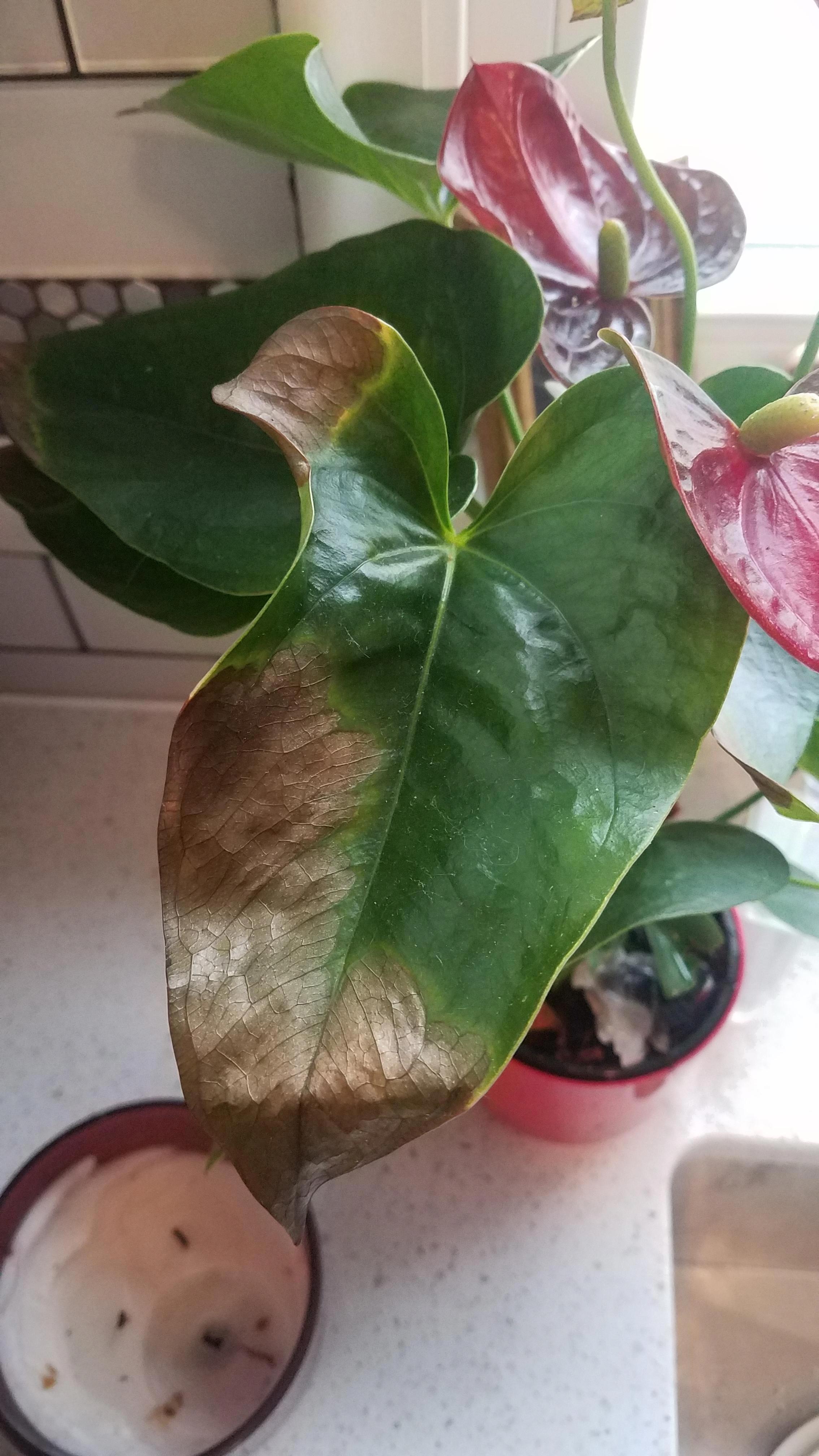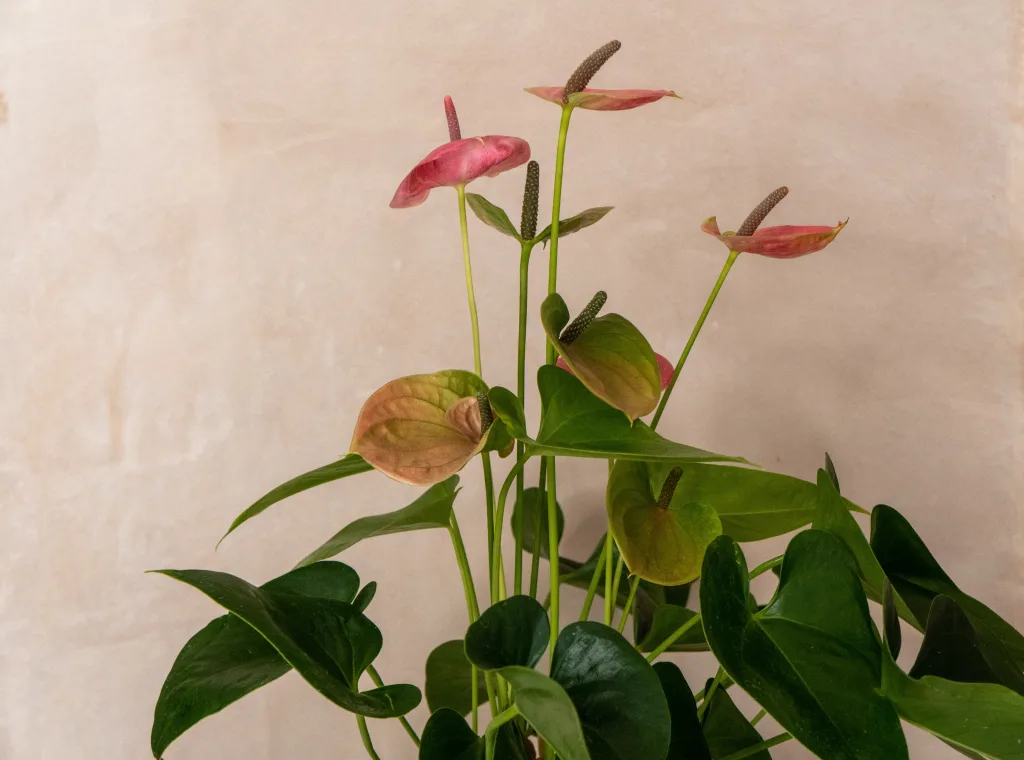Anthurium plants are known for their stunning and vibrant flowers, but sometimes they can start to turn brown, leaving plant owners puzzled and concerned. In this article, we will explore the various reasons why anthurium plants may turn brown and how to bring them back to life.
One common cause of browning in anthurium plants is overwatering. When the roots of the plant are constantly submerged in water, they can become waterlogged and start to rot. This can lead to brown, mushy roots and discolored stems. To prevent overwatering, it is important to water your anthurium plant only once a week and ensure that the soil is well-draining. If you notice signs of overwatering, such as brown roots, it is important to trim off the affected parts and adjust your watering schedule.
Another factor that can contribute to browning in anthurium plants is overfertilizing. While fertilizing is important for the plant’s growth and health, too much fertilizer can cause the leaves and flowers to turn brown. It is recommended to follow the instructions on the fertilizer packaging and avoid overdoing it. If you suspect overfertilization, it is best to flush the soil with water to remove any excess nutrients.
Exposure to too much sunlight can also cause anthurium flowers to turn brown. These plants prefer bright, indirect light, so placing them in direct sunlight can lead to sunburn and browning. To prevent this, it is important to find a well-lit spot for your anthurium plant, but ensure that it is not directly exposed to the sun’s harsh rays.
Cold stress is another common reason for browning in anthurium plants. These tropical plants thrive in warm temperatures and can be sensitive to cold drafts or temperatures below 60°F (15°C). If your anthurium is placed in a cold environment, it may start to show signs of distress, including browning of the leaves and flowers. To prevent this, it is important to keep your plant in a warm and stable environment.
Lastly, pest infestations can also cause browning in anthurium plants. Common pests that can affect these plants include aphids, mealybugs, and spider mites. These pests can feed on the plant’s sap, causing damage and discoloration. If you suspect a pest infestation, it is important to treat it promptly using organic or chemical pesticides, following the instructions carefully.
To bring an anthurium plant back to life, there are a few steps you can take. First, ensure that your plant is placed in a lighter spot, but avoid direct sunlight. Anthurium plants thrive in bright, indirect light. Additionally, adjust your watering schedule to water your plant only once a week, allowing the soil to dry out between waterings. Finally, giving your plant a little extra plant feed can help boost its growth and revive it.
In some cases, repotting your anthurium plant may also be necessary. This can help refresh the soil and provide the plant with fresh nutrients. When repotting, ensure that the new pot has good drainage and use a well-draining potting mix.
Browning in anthurium plants can be caused by various factors, including overwatering, overfertilizing, too much sunlight, cold stress, and pest infestations. By identifying the underlying cause and taking appropriate measures, you can bring your anthurium plant back to life and enjoy its beautiful, vibrant flowers once again.
Should I Cut The Brown Leaves Off My Anthurium Plant?
It is recommended to cut off brown leaves from your Anthurium plant. This is because brown leaves are a sign of natural aging or damage to the plant. By removing these brown leaves, you allow the plant to allocate more energy towards retaining its healthy growth. Cutting off the brown leaves can also help improve the overall appearance of the plant.
To remove the brown leaves, you will need a pair of sharp shears or scissors. Carefully trim off the brown leaves at the base, close to where they connect to the stem. Make sure to sanitize your tools before and after use to prevent the spread of any potential diseases or pests.
It is important to note that cutting off brown leaves should only be done when they are completely brown and dry. If the leaves are still partially green or have some signs of life, it may be best to leave them on the plant as they may still contribute to the plant’s growth and health.
Regularly inspect your Anthurium plant for any brown or wilted leaves, as well as any faded or spent flowers. By promptly removing these, you can help promote the plant’s overall health and encourage new growth and blooming.

What Does Overwatered Anthurium Look Like?
When an Anthurium is overwatered, it can develop symptoms that indicate root rot. Here’s what you can observe in an overwatered Anthurium:
1. Root discoloration: The roots of an overwatered Anthurium will appear brown instead of the healthy white color. They may also feel mushy or soft to the touch.
2. Stem discoloration: Overwatering can cause the stems of the Anthurium to turn brown or black. This discoloration usually starts from the base of the stem and can gradually spread upwards.
3. Leaf wilting: Overwatered Anthuriums often exhibit wilting leaves, which may appear droopy or limp. The leaves may also turn yellow or develop brown spots.
4. Leaf yellowing: Excessive watering can lead to yellowing of the leaves, especially if the root rot is affecting the plant’s ability to absorb nutrients properly.
5. Foul odor: Overwatering can create a stagnant and damp environment in the soil, which can lead to the growth of harmful fungi and bacteria. As a result, an overwatered Anthurium may emit a foul odor.
To prevent overwatering and root rot, it is essential to ensure the Anthurium is planted in well-draining soil and to water it only when the top inch of the soil feels dry. Additionally, providing adequate drainage and avoiding waterlogging can help maintain the plant’s health.
Why Is My Anthurium Flowers Turning Brown?
Anthurium flowers can turn brown due to several reasons. It is important to identify the cause in order to address the issue and prevent further damage. Here are the most common causes of browning in Anthurium flowers:
1. Overwatering: Excess water can lead to root rot, which prevents the plant from absorbing nutrients properly. This can result in browning of the flowers. Ensure that the soil is well-drained and only water the plant when the top inch of soil feels dry.
2. Overfertilizing: Too much fertilizer can cause salt buildup in the soil, leading to burning of the roots. This can affect the overall health of the plant, including the flowers. Follow the recommended fertilizer dosage and frequency for Anthurium plants.
3. Too much sunlight: Anthuriums prefer bright, indirect light. Exposure to direct sunlight can cause the flowers to brown and wilt. Place the plant in a location where it receives bright but filtered light, or use curtains or blinds to protect it from harsh sunlight.
4. Cold stress: Anthuriums are tropical plants and are sensitive to cold temperatures. Exposure to cold drafts or temperatures below 60°F (15°C) can cause the flowers to turn brown. Keep the plant away from cold windows or air conditioning vents.
5. Pest infestations: Certain pests, such as spider mites or thrips, can damage Anthurium flowers, causing them to brown and deteriorate. Regularly inspect your plant for signs of pests and take appropriate measures, such as using insecticidal soap or neem oil, to control infestations.
Browning of Anthurium flowers can be caused by overwatering, overfertilizing, excessive sunlight, cold stress, or pest infestations. By addressing these factors and providing optimal growing conditions, you can help maintain the health and vibrancy of your Anthurium flowers.
How Do You Revive A Dying Anthurium Plant?
To revive a dying Anthurium plant, follow these steps:
1. Adjust the lighting: Anthurium plants prefer bright, indirect light. Place your plant in a location with adequate light, but avoid direct sunlight as it can scorch the leaves.
2. Water properly: Check the soil moisture before watering. Anthuriums like slightly moist soil, but they don’t tolerate overwatering. Water the plant once a week, allowing the top inch of soil to dry out between waterings. Avoid letting the plant sit in standing water, as it can lead to root rot.
3. Provide additional nutrients: If your Anthurium is struggling, it may benefit from a little extra plant feed. Choose a balanced, water-soluble fertilizer and dilute it according to the package instructions. Apply the fertilizer every 4-6 weeks during the growing season.
4. Consider repotting: If your Anthurium is showing signs of distress, such as root bound or compacted soil, it may benefit from repotting. Choose a pot that is slightly larger than the current one, and use well-draining soil mix suitable for Anthuriums. Gently remove the plant from its current pot, loosen the roots, and place it in the new pot. Fill in with fresh soil, ensuring that the plant sits at the same depth as before.
Remember, it may take some time for your Anthurium to recover, so be patient. With proper care and attention, your plant should gradually regain its health and vitality.

Conclusion
Anthurium plants require proper care and attention to thrive and maintain their vibrant appearance. It is important to address any wilting or yellowing leaves or flowers by promptly removing them to redirect the plant’s energy towards healthy growth. Overwatering should be avoided as it can lead to root rot, characterized by brown and mushy roots and discolored stems. This issue can be caused by either watering frequency or soil issues. Browning of Anthurium flowers can be caused by several factors, including overwatering, overfertilizing, excessive sunlight, cold stress, or pest infestations. To revive a struggling Anthurium plant, it is advisable to place it in a well-lit but not directly sunlit area, water it once a week, and provide it with a little extra plant feed. Repotting the plant may also be considered if necessary. By following these guidelines and providing the appropriate care, you can bring an Anthurium plant back to life and enjoy its beautiful and vibrant blooms.
